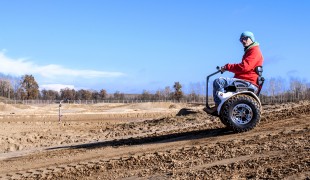- 5004
- 337
- 3
- 4
- 0
- Help Ukraine
About the solution
“Communication was one of the first challenges that we were able to use 3D printing to help solve. Tanner was communicating with us by pointing at what he needed and grunting, but he couldn’t tell us. He was learning some sign language, but his therapists at his school thought he could do more than that”, the father explained.
Tanner was using an app in the iPad of the school. The software shows icons in various customizable groupings, and he could select the images which the iPad would verbalize for him. It was working well but it led to a problem, that was Tanner’s wheelchair, because it was hard for him to hold an iPad and operate the wheelchair.
There were wheelchair mounts, but they were very expensive. The school’s therapists let Tanner use one temporarily. It worked well, and it consisted of a simple apparatus, a plate and a mount with a goose-neck in between. So Paul decided to built one himself, using 3D printing.
“I had no modeling experience at the time, and thought this would be a perfect way for me to learn. So, I fired up Fusion360 and modeled the plate and the base. I ordered a goose-neck for a microphone, put that in between the parts, and like magic Tanner had his own customized iPad mount. It even matched the color of his wheelchair!”, the inventor said.
The next challenge was walking, as Tanner was five years old at the time, and there was no medical reason for him to not be walking.
Paul signed up his son in a program called Adaptive Aquatics. This program specializes in helping children with special needs with movement and mobility issues as well as building their confidence, in the water. While floating in the water using a specialized float, the team was able to get him to kick his legs and move his arms, and make walking movements with his legs.
It was working, but it was hard for the instructors, because the bench required two people to operate when Tanner was walking on it as he had no balance and the bench system had no rails except on the far ends. After talking with an instructor, a plan was hatched, and Paul’s next practical 3D printing project began, so that Tanner would have a bench we would be able to operate by himself.
The solution of a bench, made of PVC with a flat surface, and end rails along the narrow sides.
“The first several attempts failed for various reasons, but ultimately, we were successful! Specialized ends were developed that will fit on the ends of a PVC pipe that will clamp to the bench, and using bolts with 3 printed knobs that could be removed easily. We tried it with Tanner and almost immediately Tanner was using the system without instructors having to hold onto his hands! Within a week, other children were using the solution as well, and to this day it is still in use (although the solution continues to be modified)”, Paul expressed.
Tanner now walks and speaks.
Adapted from: http://bit.ly/2scU3St
https://youtu.be/cUNiGDX0QD0
This solution shall not include mention to the use of drugs, chemicals or biologicals (including food); invasive devices; offensive, commercial or inherently dangerous content. This solution was not medically validated. Proceed with caution! If you have any doubts, please consult with a health professional.
DISCLAIMER: This story was written by someone who is not the author of the solution, therefore please be advised that, although it was written with the utmost respect for the innovation and the innovator, there can be some incorrect statements. If you find any errors please contact the patient Innovation team via info@patient-innovation.com



 en
en